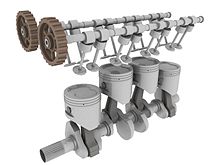
Back Inlynviersilinder Afrikaans محرك ذو أربع اسطوانات مرتبة في خط مستقيم Arabic Motor de cuatro cilindros en llinia AST Ardıcıl dörd silindrli mühərrik Azerbaijani Motor de quatre cilindres en línia Catalan Čtyřválcový řadový motor Czech Rækkemotor-4 Danish Motor de cuatro cilindros en línea Spanish موتور چهارسیلندر خطی Persian Moteur avec quatre cylindres en ligne French



A straight-four engine (also referred to as an inline-four engine) is a four-cylinder piston engine where cylinders are arranged in a line along a common crankshaft.
The majority of automotive four-cylinder engines use a straight-four layout[1]: pp. 13–16 (with the exceptions of the flat-four engines produced by Subaru and Porsche)[2] and the layout is also very common in motorcycles and other machinery. Therefore the term "four-cylinder engine" is usually synonymous with straight-four engines. When a straight-four engine is installed at an inclined angle (instead of with the cylinders oriented vertically), it is sometimes called a slant-four.
Between 2005 and 2008, the proportion of new vehicles sold in the United States with four-cylinder engines rose from 30% to 47%.[3][4] By the 2020 model year, the share for light-duty vehicles had risen to 59%.[5]
- ^ Cite error: The named reference
Nunneywas invoked but never defined (see the help page). - ^ "Performance: The new 718 Boxster". Porsche. 2016. Retrieved 2016-11-01.
- ^ Schembari, James (2010-10-15). "A Family Sedan Firing on Fewer Cylinders - 2010 Buick LaCrosse CX - Review". The New York Times.
- ^ Ulrich, Lawrence (2010-08-13). "Four-Cylinder Engines Are Smaller, Quieter and Gaining New Respect". The New York Times.
- ^ "Explore the Automotive Trends Data". November 2021. Retrieved 2021-11-25.